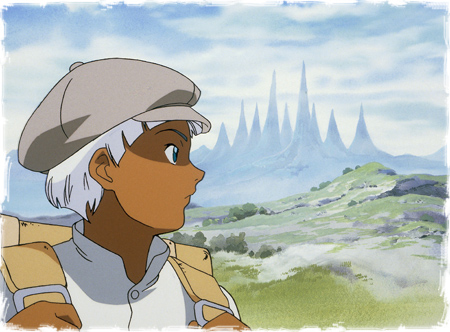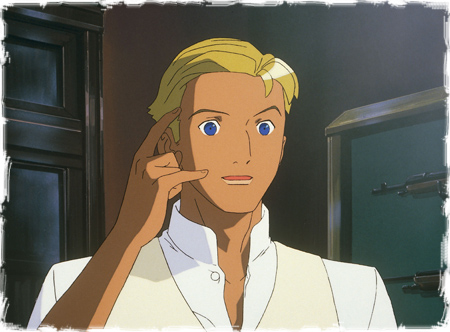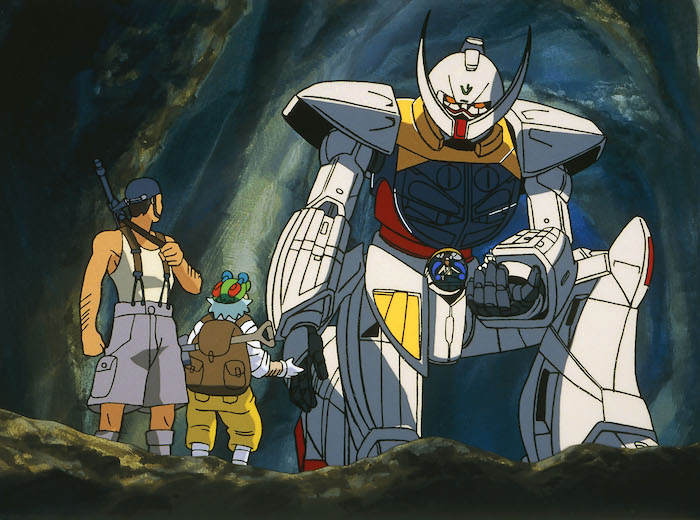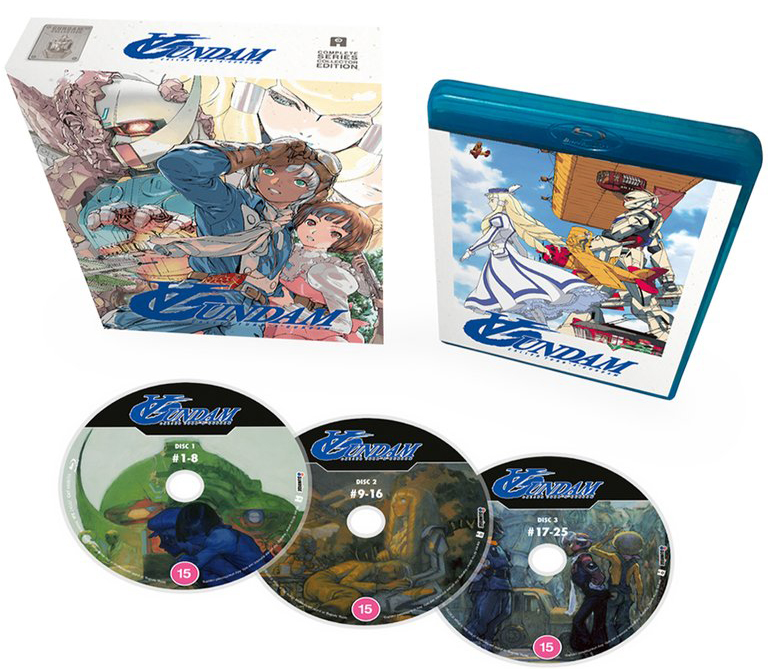Turn A Gundam: Part 1 Review
Set in the year 2345 of the Correct Century, Turn A Gundam focusses on the burgeoning war between the Moonrace, a group of humans who fled an inhospitable and war-torn Earth 2000 years ago, and the descendants of the Earth-dwelling humans who were left behind. After all that time spent living on the moon, the Moonrace have decided, for whatever reason, that it is time to return to Earth, and have been negotiating with the countries of North Ameria (yes, that’s not a typo!) to allow the Moonrace to settle in the continent’s Sunbelt region.
In preparation for the return to Earth, the Moonrace have been sending down scouts to integrate themselves into Earth society and determine if it was suitable for the Moonrace to return to. Loran Cehack, Fran Doll and Keith Laijie are three of these scouts that, after some trials and tribulations, find themselves loving their new lives on Earth, with Loran being employed as a chauffeur for the well-to-do Heim family, Keith becoming a baker, and Fran becoming a photographer for the Inglessian newspapers.
However, their peaceful lives don’t last, as during Loran’s coming-of-age ceremony, the Moonrace begin their return and end up in conflict with the Earth’s Militia, who see them as invaders. As their homes burn around them, the ancient statue used in his town’s coming-of-age ceremony, the towering “White Doll”, suddenly comes to life and reveals itself to be the white mobile suit known as the Turn A Gundam. Dragged into the war on the side of the Earth Militia, Loran must now fight to win back the peace and protect not only his newfound friends on Earth, but also his beloved Moonrace Princess, Dianna Soriel.

Right from the off, Turn A Gundam feels quite different to the Gundam series that came before it, yet it still has enough familiarity in that you can still tell it is definitely a Gundam show. It initially has a more light-hearted and comedic tone, but also offers characters and a story that have surprising depth and meaning as the central conflict unfolds. In this way it feels like they finally got right what they were initially going for with ZZ, as it is fun and engaging without having to resort to some of that series’ sillier comic-relief moments, like the whole Moon Moon escapade, for example.
It’s also quite remarkable that we never touch and barely see outer space in the opening 25 episodes. The entire first half of the story is set on Earth and it gives the series a very different perspective, tying the action sequences into its central plot element of the human destruction of Earth. As the Moonrace move in and battles start ripping the planet into pieces again, there’s very much a sense of urgency and desperation around this wanton destruction.
This leads to a fun episode in the latter part of this set where our heroes have to protect a farm from being destroyed by a nearby battle, which also offers up one of the series’ many great character-building moments. The way the characters develop over time seems well thought out, and, as in this episode in particular, the way character relationships connect with each other can often be very clever.
It helps that the characters are very likable and well grounded on all sides, and are a very diverse bunch. While it’s not like they haven’t included black characters in Gundam before, it’s good to see some ethnic diversity with both lead protagonist Loran and the Inglessian ruler Guin Rhineford being black, while there’s some cultural diversity by adding a trio of hippies into the enemy side.

I wouldn’t say Loran is too different from most Gundam protagonists, being very much caught in the middle and hypocritically fighting against his native Moonrace people despite wanting peace between both them and the people of Earth; yet he feels one of the more likable ones, not being an emotionless tin robot, nor over-exaggerating every little thing. He’s still passionate though, particularly for his friends and people he cares about, and always goes above and beyond for them, even if that does prove a weakness as he is rather easy to manipulate. Sadly, his two Moonrace friends, Keith and Fran, do get side-lined quite a bit, despite being interesting characters, although Keith does kind-of come into his own later on as the bakery he works for ends up getting caught in-between the warring factions.
Surprisingly, it’s the female characters that really drive the show forward, with a lot of focus given to the Heim sisters and Princess Diana, particularly as they become more involved in the progression of the war, and it’s interesting to see how the characters change as their plight unravels. You’ll quickly notice that Diana and Kihel look exactly alike, which I thought was something used to good effect as the series progresses. Meanwhile, the other Heim sister, Sochie, really finds her place in the Earth Militia, no matter how misguided her decision to join the army might be.
Sunrise’s animation is generally strong and the show does look very good, mostly helped by its strong, bright colours and steampunk-esque world design that is heavily inspired by early 1900s America. I did find that this meant it wasn’t as action-heavy as some other Gundam shows, and it’s definitely rather different, starting off with World War 1 era fighter planes, but it does allow it to focus on the developing story rather than just push out fight after fight, particularly early on. Don’t worry, though; if it’s thrilling mech battles that you’re after, there’s still some great mobile suit action to get your teeth into.

There’s plenty of Gundam fanservice here too, as with this part of the Gundam metaverse designed to unify all of the previous Gundam series into one timeline, (a tactic used by various other multimedia franchises to varying degrees of success) you get to see some familiar mobile suits among those designed for this series. While I highly enjoyed seeing the old ones as a fan of the franchise, I also quite like these newer ones too, particularly the ball-like Kapool (which I was already familiar with due it being used in the Build series). And of course, this was the series that legendary designer Syd Mead worked on, and I do like what he contributed here – the Turn A Gundam is very distinctive with its crescent moon moustache, while the SUMO’s sumo wrestler appearance is right on the nose.
I also love the soundtrack for the show, composed by Yoko Kanno, and when combined with the lush visuals and the world building, it definitely gave me an odd sense like if Studio Ghibli made a Gundam series, then this is what it would turn out like. The opening theme for this part of the series, “Turn A Turn” by Hideki Saijo, isn’t quite as iconic as ZZ’s “Anime Ja Nai ~Yume o Wasureta Furui Chikyūjin yo~”, but it does has a similar sort of vibe, while Shinji Tanimura’s “Aura” is certainly a rather mournful ending theme.
Anime Limited’s release features Episodes 1 to 25 of the series, although it is worth calling out that Episode 16 is a recap, which I found a little confusing when going through the discs. It’s also a subtitle-only release as the series never received an English dub. The subtitling is clear and easy to read, while the Japanese performance is generally really good with a solid voice acting cast featuring the likes of Romi Park (Fullmetal Alchemist, Bleach) and Jun Fukuyama (Assassination Classroom, Code Geass). On-disc extras feature the clean opening and closing animations, while the release also comes with a collector’s box to store both parts of the series.

The best way I can describe Turn A Gundam is if Studio Ghibli made a Gundam series then this is probably what it would be like. With its lush, vivid scenes and steampunk world trappings it feels like an industrial fantasy, with a strong story that has an important message. However, it still retains its Gundam roots with some great mecha designs and exciting action scenes. It may be the last pre-digital era Gundam, but so far, it’s proving to be one of the best.


